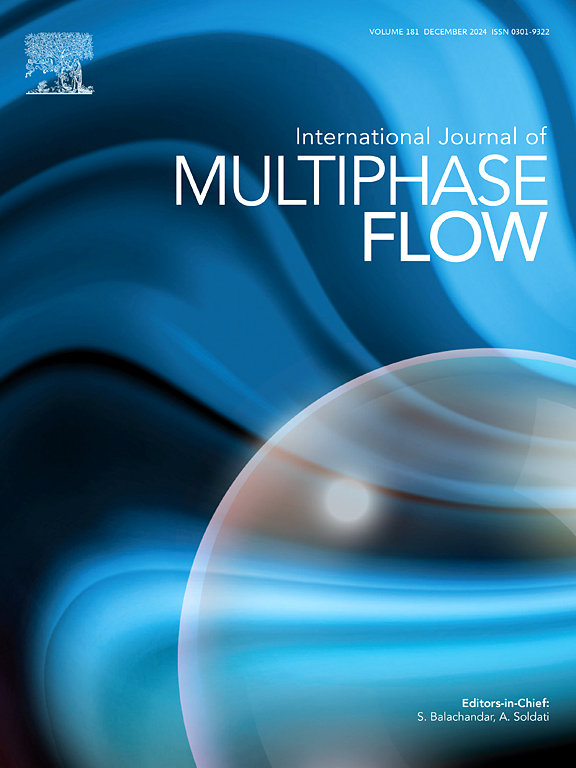Modal analysis reveals imprint of snowflake shape on wake flow structures
IF 3.8
2区 工程技术
Q1 MECHANICS
International Journal of Multiphase Flow
Pub Date : 2025-07-23
DOI:10.1016/j.ijmultiphaseflow.2025.105365
引用次数: 0
Abstract
This study investigates the complex interplay of wake flow dynamics, particle shape, and falling behavior of snowflakes through advanced flow analysis. We employ Proper Orthogonal Decomposition and Dynamic Mode Decomposition to analyze the wake flow patterns of three distinct snowflake geometries at a Reynolds number of 1500: a dendrite crystal, a columnar crystal, and a rosette-like particle. Proper Orthogonal Decomposition reveals that spatial resolution significantly impacts the capture of flow structures, particularly for particles with more intricate wake flow structure, corresponding to unstable falling motion. Dynamic Mode Decomposition demonstrates high sensitivity to temporal resolution, with data of the forces exerted on the snowflake incorporated in the matrix prior to the decomposition mitigating information loss at lower sampling rates. We establish a linear relationship between snowflake shape porosity and minimum and maximum Dynamic Mode Decomposition eigenfrequencies, absolute decay or growth rates, and the wavenumber of the most energetic mode, linking particle geometry to wake flow characteristics. Higher porosity corresponds to more stable, small-scale flow structures and steady falling motion, while lower porosity promotes larger, unstable structures and falling trajectories with random particle orientations. These findings reveal the interdependence of snowflake geometry, wake flow dynamics, and falling behavior and highlight the importance of considering both spatial and temporal resolutions when dealing with modal analysis. This research contributes to improved predictions of snowflake falling behavior, with potential applications in meteorology and climate science.

模态分析揭示了雪花形状对尾流结构的影响
本研究通过先进的流动分析研究了尾流动力学、颗粒形状和雪花飘落行为之间复杂的相互作用。本文采用适当的正交分解和动态模态分解分析了雷诺数为1500时三种不同形状雪花的尾流模式:枝晶、柱状晶体和玫瑰状颗粒。适当的正交分解表明,空间分辨率显著影响流动结构的捕获,特别是对于具有更复杂尾流结构的颗粒,对应于不稳定的下落运动。动态模式分解显示出对时间分辨率的高灵敏度,在分解之前将施加在雪花上的力的数据合并到矩阵中,从而在较低的采样率下减轻信息损失。我们建立了雪花形状孔隙度与最小和最大动态模态分解特征频率、绝对衰减或增长速率以及最具能量模态的波数之间的线性关系,将颗粒几何形状与尾流特性联系起来。孔隙度越高,流体结构越稳定、规模越小,下落运动越稳定;而孔隙度越低,流体结构越不稳定,下落轨迹越随机,颗粒取向也越随意。这些发现揭示了雪花几何形状、尾流动力学和下落行为之间的相互依存关系,并强调了在处理模态分析时同时考虑空间和时间分辨率的重要性。这项研究有助于改进对雪花飘落行为的预测,在气象学和气候科学中具有潜在的应用价值。
本文章由计算机程序翻译,如有差异,请以英文原文为准。
求助全文
约1分钟内获得全文
求助全文
来源期刊
CiteScore
7.30
自引率
10.50%
发文量
244
审稿时长
4 months
期刊介绍:
The International Journal of Multiphase Flow publishes analytical, numerical and experimental articles of lasting interest. The scope of the journal includes all aspects of mass, momentum and energy exchange phenomena among different phases such as occur in disperse flows, gas–liquid and liquid–liquid flows, flows in porous media, boiling, granular flows and others.
The journal publishes full papers, brief communications and conference announcements.

 求助内容:
求助内容: 应助结果提醒方式:
应助结果提醒方式:


